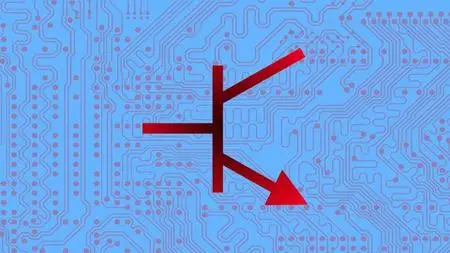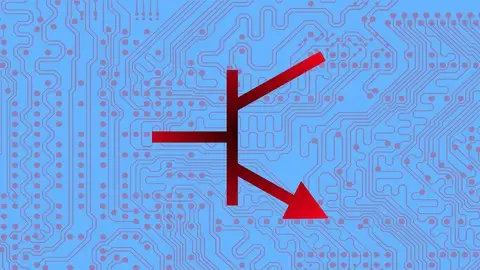Electronic Circuits - Part3: Bipolar Junction Transistors
Published 5/2023
MP4 | Video: h264, 1280x720 | Audio: AAC, 44.1 KHz
Language: English | Size: 4.39 GB | Duration: 8h 36m
Published 5/2023
MP4 | Video: h264, 1280x720 | Audio: AAC, 44.1 KHz
Language: English | Size: 4.39 GB | Duration: 8h 36m
Analysis and Design of BJT circuits (including Multisim simulations, and practical experiments)
What you'll learn
BJT structure, transistor currents, and minority carrier distribution.
Common Emitter (CE), Common Base (CB), and Emitter Follower (CC) configurations.
Characteristics and modeling of bipolar junction transistor (LARGE SIGNAL and small signal modeling).
Different operating regions of a BJT (cutoff, saturation, and forward active region).
BJT biasing and Stability factors.
DC and ac analysis of BJT circuits.
Design for maximum symmetrical swing and best stability.
Bias compensation techniques.
Different amplifier configurations.
Miller theorem, bootstrap technique, and Darlington pair.
BJT current sources.
Multistage amplifiers.
Analysis and design of practical BJT circuits.
Circuit analysis with Multisim (create you own BJT model with SPICE netlist)
Requirements
You should be familiar with linear circuit analysis techniques such as KVL, KCL, mesh, and nodal analysis. (These methods are reviewed in the second part of the course).
You should be familiar with basic components such as resistors, capacitors, inductors, and diodes.
You should have a basic understanding of calculus and linear algebra.
It is recommended that you have the Multisim software.
NI myDAQ (Suggested. It works well with Multisim. You may also use your own instruments).
Description
In this part of the “Electronic Circuits” course, you will get familiar with one of the most widely used nonlinear components which is the Transistor. You will get familiar with the characteristics and applications of a bipolar junction transistor (BJT). The bipolar junction transistor enables you to amplify current and voltages, when used in conjunction with other electronic components like resistors and capacitors. It can also be used as a switch to turn various components of your electronic circuits on and off. After finishing this course you will understand two crucial transistor functions—amplification and switching—that are essential to the creation of electronic circuits.For this purpose, I will start with the physical structure of the BJT. After you get familiar with transistor currents and carrier distribution inside the transistor, you will learn how to model the BJT in cutoff, saturation, and forward active regions (all these models are derived from the Ebers-Moll model). Next, you will learn how to perform DC and ac analysis. You will get familiar with stability factors and maximum output symmetrical swing, and learn how to design a BJT circuit for maximum stability, maximum output symmetrical swing, and maximum gain. In this course, you will learn different types of BJT amplifier configurations (CE, CB, and CC). I will show you some special techniques such as the Miller theorem and Bootstrap technique, and also, special BJT arrangements such as a Darlington pair. You will get familiar with multistage amplifier circuits which are followed by some practical BJT circuit experiments. Finally, I’ll demonstrate how to perform simulations in Multisim. Finally, you will learn how to create SPICE netlists, then create and simulate your own BJT models in Multisim.
Overview
Section 1: Introduction
Lecture 1 01-01 - Course Outline
Lecture 2 01-02 - Course Introduction
Section 2: BJT Structure
Lecture 3 02-01 - BJT Structure01
Lecture 4 02-02 - BJT Structure02
Lecture 5 02-03 - Transistor Currents
Lecture 6 02-04 - Questions (BJT Terminal Currents)
Lecture 7 02-05 - Minority Carrier Distribution
Lecture 8 02-06 - Questions
Section 3: BJT Circuit Configurations
Lecture 9 03-01 - BJT Circuit Configurations
Lecture 10 03-02 - Common Emitter Configuration p1
Lecture 11 03-03 - Common Emitter Configuration p2
Lecture 12 03-04 - Common Emitter Examples
Lecture 13 03-05 - Common Base Configuration
Lecture 14 03-06 - Common Base Examples
Lecture 15 03-07 - Common Collector Configuration
Section 4: Large Signal Modeling and DC Analysis
Lecture 16 04-01 - BJT Large Signal Modeling
Lecture 17 04-02 - Large Signal Model in Forward Active Region
Lecture 18 04-03 - Saturation and Cutoff Regions
Lecture 19 04-04 - Some Points to Remember
Lecture 20 04-05 - DC Analysis P1
Lecture 21 04-06 - DC Analysis P2
Lecture 22 04-07 - DC Analysis P3
Lecture 23 04-08 - DC Analysis P4
Lecture 24 04-09 - DC Analysis P5
Lecture 25 04-10 - DC Analysis P6
Lecture 26 04-11 - DC Analysis P7
Lecture 27 04-12 - DC Analysis P8
Lecture 28 04-13 - DC Analysis P9
Lecture 29 04-14 - DC Analysis P10
Lecture 30 04-15 - Design Examples
Section 5: BJT Biasing, Stability Factors, ac Analysis and Swing
Lecture 31 05-01 - BJT Biasing
Lecture 32 05-02 - Fixed Bias
Lecture 33 05-03 - Emitter Bias
Lecture 34 05-04 - Voltage Divider Bias
Lecture 35 05-05 - Self-Bias Design Example
Lecture 36 05-06 - Integrated Circuit Biasing
Lecture 37 05-07 - Stability Factors
Lecture 38 05-08 - Stability Factor Example
Lecture 39 05-09 - Design Examples
Lecture 40 05-10 - CC and CB Biasing
Lecture 41 05-11 - Bias Compensation
Lecture 42 05-12 - Bias Compensation Examples
Lecture 43 05-13 - BJT Small Signal Modeling 01
Lecture 44 05-14 - BJT Small Signal Modeling 02
Lecture 45 05-15 - BJT Small Signal Modeling 03
Lecture 46 05-16 - ac Analysis Examples
Lecture 47 05-17 - Max Symmetrical Swing 01
Lecture 48 05-18 - Max Symmetrical Swing 02
Lecture 49 05-19 - Swing Examples 01
Lecture 50 05-20 - Swing Examples 02
Lecture 51 05-21 - Design Examples 01
Lecture 52 05-22 - Design Examples 02
Lecture 53 05-23 - Design Considerations
Section 6: Amplifier Configurations
Lecture 54 06-01 - CE Amplifier
Lecture 55 06-02 - CE Examples 01
Lecture 56 06-03 - CE Examples 02
Lecture 57 06-04 - CE Design Examples
Lecture 58 06-05 - CE with Emitter Degeneration p1
Lecture 59 06-06 - CE with Emitter Degeneration p2
Lecture 60 06-07 - Degenerated CE Examples
Lecture 61 06-08 - CB Amplifier
Lecture 62 06-09 - CB Examples
Lecture 63 06-10 - CC Amplifier
Lecture 64 06-11 - CC Examples
Lecture 65 06-12 - CC Design Examples
Lecture 66 06-13 - Amplifiers Comparison
Lecture 67 06-14 - Miller Theorem
Lecture 68 06-15 - Bootstrap Technique
Lecture 69 06-16 - Darlington Pair
Lecture 70 06-17 - Current Sources
Lecture 71 06-18 - ac Analysis p1
Lecture 72 06-19 - ac Analysis p2
Lecture 73 06-20 - ac Analysis p3
Section 7: Multi-Stage Amplifiers
Lecture 74 07-01 - Multistage Amplifiers 01
Lecture 75 07-02 - Multistage Amplifiers 02
Lecture 76 07-03 - Multistage Amplifiers 03
Lecture 77 07-04 - Design Example
Lecture 78 07-05 - Exercise 01
Lecture 79 07-06 - Exercise 02
Section 8: Practical Experiments
Lecture 80 08-01 - Identifying BJT
Lecture 81 08-02 - Using Datasheets
Lecture 82 08-03 - Light Controlled LED
Lecture 83 08-04 - Light Controlled Bulb
Lecture 84 08-05 - Level Detector
Lecture 85 08-06 - Audio Amplifier 01
Lecture 86 08-07 - Audio Amplifier 02
Lecture 87 08-08 - Audio Amplifier 03
Section 9: Circuit Analysis with Multisim
Lecture 88 09-01 - First Simulation in Multisim
Lecture 89 09-02 - Creating SPICE Netlist
Lecture 90 09-03 - BJT DC Model 01
Lecture 91 09-04 - BJT DC Model 02
Lecture 92 09-05 - Large Signal Analysis
Lecture 93 09-06 - BJT ac Model
Lecture 94 09-07 - Voltage Gain
Lecture 95 09-08 - Input_Output Resistances
Lecture 96 09-09 - Multisim BJT Model
Section 10: Conclusion (Bonus Lecture)
Lecture 97 10-01 - The End
This course is intended for students who are already familiar with fundamental electronic circuits (circuits that contain resistors, capacitors, inductors, diodes, and so on) and wish to expand their knowledge to semiconductor devices such as bipolar junction transistor circuits. Anyone taking this course should be familiar with basic circuit analysis theories and techniques such as Ohm's law, Kirchhoffe's voltage and current laws (KVL and KCL), Thevenin's theorem, and so on. This course is also very useful for university students studying Analog Electronics / Electronic Circuits. ***IF YOU HAVE NO EXPERIENCE WITH ELECTRICAL CIRCUITS, THIS COURSE IS NOT FOR YOU.***



